Now the construction of private residential buildings in the style of scandi, hi-tech, or minimalism is gaining popularity. Agree, when the design of buildings strives for simplicity and conciseness, multi-level roofs no longer fit into the overall concept. They are being replaced by lean-tos, familiar to European buildings. Having studied how to build a pitched roof with your own hands step by step, you can significantly save the budget when building a house.
For the construction of such a roof, fewer materials will be required. Therefore, the cost of its device will be lower. A shed design is much easier to design and build. After reviewing the calculations and the list of necessary materials, you can independently create a reliable and durable roof.
Our article will help you understand the technology of building a roof with one slope using ready-made examples. By following the requirements and following the step-by-step instructions, as a result you will get not only a durable, but also a stylish design that harmoniously complements the style of your home and landscape design.
The content of the article:
- Design features of a shed roof
- Advantages and disadvantages of a pitched roof
- How to calculate the level of inclination?
- Selection of materials and calculation of their quantity
- Types of roof supports
-
Shed roof construction instruction
- Step # 1 - installation of a roofing mauerlat
- Step # 2 - Assembly of the truss system
- Step # 3 - installation of roofing thermal insulation
- Step #4 - Creating the Roof Sheathing
- The choice of material for the roof
- Conclusions and useful video on the topic
Design features of a shed roof
Shed technology assumes the presence of one pitched area, erected using a truss system. The bearing part is made of boards and timber.
The edges of the rafter legs are classified as layered, as they have support under them. For coating, corrugated board, sheet material, soft roofing in rolls, ondulin, plastic, ceramic tiles, metal tiles, etc. can be used.
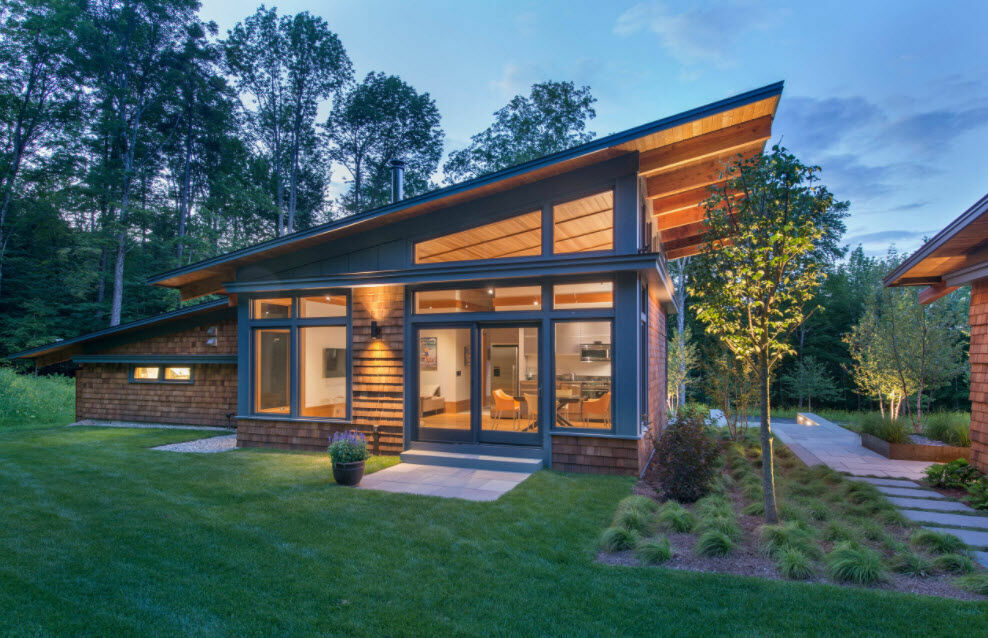
The feature of a single-slope design with a strong slope minimizes the possibility of accumulation of snow masses and water. Removal of precipitation occurs automatically due to the difference in the height of the supporting walls. If the roof system has a flat shape, it must be equipped with a gutter for water drainage.
Depending on the functional purpose, shed roofs are divided into:
- Non-ventilated. More often they are installed during the construction of utility and working premises or terraces.
- Ventilated. Assume the presence of an air gap between the insulating and waterproofing material.
Each element of the supporting structure is laid in turn and fixed on two walls of the building, different in height. All elements are connected by means of a Mauerlat.
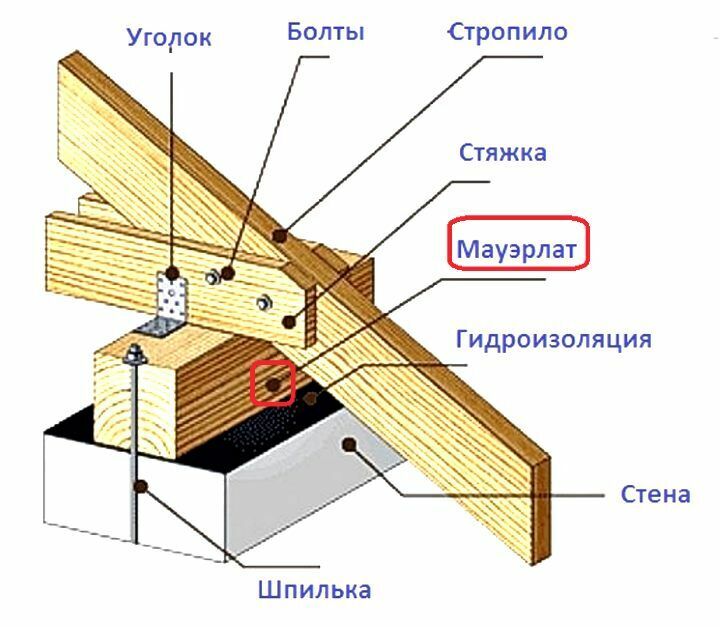
Mauerlat - a log or beam laid on top of the front and rear walls. Its function is the lower support for attaching rafters.
A single-slope roof may have different support elements, depending on the intended height and design.
As a support are used:
- supporting pillars, on which the casing can be attached in the future;
- load-bearing structures made of foam concrete, brick or wood.
Shed roof includes several varieties: it can be with attic or without it, cold or equipped with thermal insulation. Between the ceiling of the house and the roof, you can equip a residential semi-attic or utility area.
Advantages and disadvantages of a pitched roof
When choosing the type of roof, it is necessary to take into account all the positive and negative characteristics of each option. Below are the features of single-pitched roofs.
The main advantages of a pitched roof are the quick construction process, ease of installation and low weight. The minimum allowable angle of inclination for such a roof is 5 degrees.
By directing the slope to the south side, you can reduce heat loss. The low windage of the roof with one slope ensures the reliability and durability of the structure, as well as the possibility of its installation in regions with high windiness.
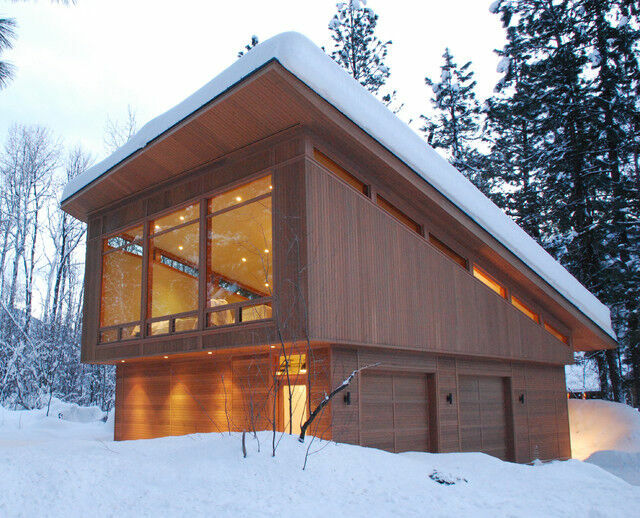
Due to the flat surface, a shed roof is considered the most resistant to natural influences. In case of accumulation of snow, it forms an even layer that exerts a uniform load on the entire structure.
Ventilation system An inclined shed roof is much simpler than a gable roof: it does not require ventilated skates and aerators. But despite the simplicity and versatility for low-rise buildings, such a roof has limitations and disadvantages.
These include:
- strictly regulated fire regulations make it difficult to create an attic or attic;
- low slope is not suitable for the Northern regions, where snowfall prevails;
- the need for mechanical cleaning of snow in winter in case of its accumulation due to the small angle of inclination.
Depending on the area and configuration of the building, a certain type of roof will be required. A single pitched roof can be installed on residential buildings with several floors, but is not suitable for multi-storey buildings.
How to calculate the level of inclination?
The key factor determining the required level of slope of a shed roof is the climate of the region. In order to prevent the accumulation of snow masses during snowfalls, in the northern regions it is recommended to design a roof with an angle of at least 30 degrees. This will reduce the load on the roof due to spontaneous snowmelt.
For geographic areas with excessive windiness, the requirements are radically opposite. A sharp angle of inclination enhances the windage of the structure, reducing its reliability. For example, the effect of wind and load on a roof with a 45 degree angle will be five times stronger than a similar roof with a slope of 10-11 degrees. The snow and wind loads of the region can be found on special maps of the area.

This map helps to accurately calculate the average annual snow load. This indicator is important when developing a pitched roof project and selecting materials.
Another parameter that affects the angle of inclination is the type of roofing material and its weight. This indicator is regulated by the manufacturer. It is necessary to build a structure taking into account the indicated recommendations. Failure to comply with this requirement may result in structural leakage.
By adding all the load values, you get the final calculation figure. Next, you need to compare it with the indicators of the table and select the parameters of the truss system.

This table shows an approximate calculation of the load exerted on the rafters. By changing the specified data to your own, you will receive the calculated load per 1 m2 roofing
The more gently sloping the roof is, the better the waterproofing should be. All joints must be treated with a liquid water-repellent composition. Bituminous mastic or special sealant is more often used.
Selection of materials and calculation of their quantity
The length of the rafters for a roof with one slope affects the size of the beam section and its quantity. A thin beam is not designed for heavy loads, therefore, in this embodiment, the rafters should be installed more tightly.
When choosing a roofing material, it is necessary to take into account not only the level of inclination of the roof structure, but also its area. A smooth surface increases precipitation slippage, while a ribbed surface reduces it. This must also be taken into account when calculating.

The table shows the parameters for choosing the bars of the desired section. To create a rafter frame, it is recommended to use wood not lower than the first grade. It should not have visible damage, deformation and mold.
For each type of roofing material, there are certain requirements for the step of the crate and installation. For tiles, the pitch is 30 cm, for slate - 44 cm. For a flexible roof, there are no strict requirements for the pitch and angle of inclination. The weight of the roofing material is indicated in the technical requirements for operation.
Types of roof supports
The design of a shed roof is based on rafter legs resting on one side against the facade wall, on the other - against the back. The front wall must be higher than the back wall to ensure the required angle of inclination of the roofing system.
If the distance between the walls does not exceed 4.5 m, the roof structure will be simple: two Mauerlat beams fixed on the walls and rafter legs resting on the Mauerlat.
When the gap between the ceiling and the roof does not exceed 4.5 m, the structure can be mounted without installing additional supports. If the gap is more than 4.5 m, you will need to install support posts under the rafters. Boards or beams can be used as supports.
There are two ways to install supports:
- Installation of supports in the center of the length of the rafters.
- Installation of a horizontal run from one beam under the rafters, passing in the middle of their length. This option will minimize the number of support posts by half.
If the width of the building is more than 6 m, the design of the truss system will be more difficult. The optimal solution in this case is a house project with a load-bearing wall that will act as a support for the racks.

The diagram shows the principles of installing rafter legs, racks and girders, depending on the width of the building. If the width of the room reaches 16 m, it is necessary to install a scramble between two support posts.
In the case of a house width of more than 12 m, additional rafter legs must be used. The manufacture of beams of non-standard size will entail an increase in financial costs. In some cases, this can be avoided with the help of fillies.
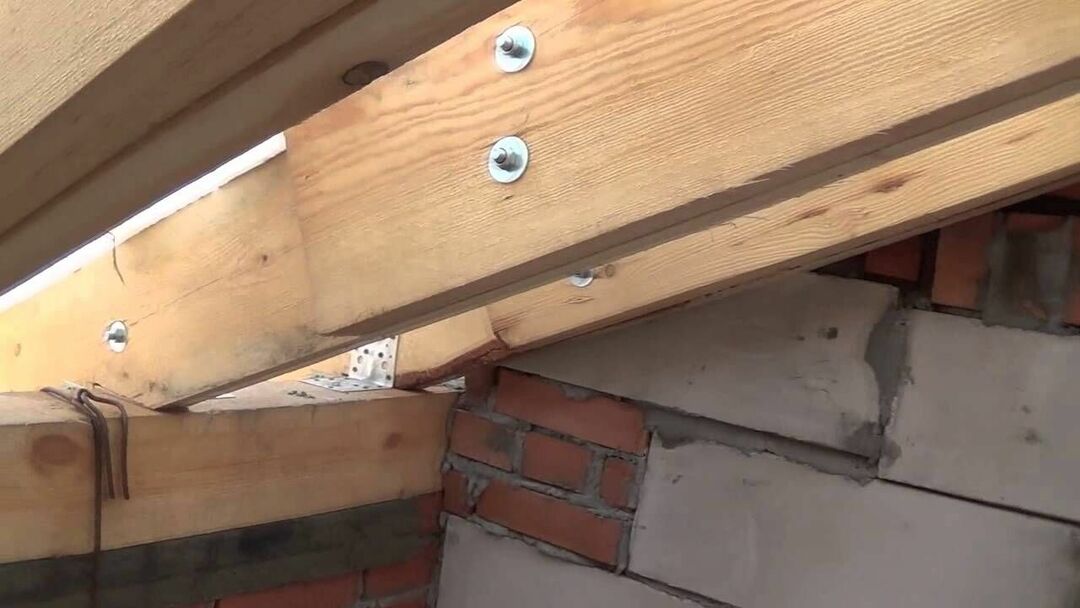
By installing fillies, the length of the beams is spliced. This option is available if only the missing width of the roof overhangs is grown
The fillies are cuts of beams of a similar section, connected to the main beams and fixed with two overlays of 60 cm each. This design is fastened with bolts or mounting plates.
Shed roof construction instruction
After making the calculations, you will need to draw up a construction plan, taking into account its type and configuration. Then you can proceed to the purchase of materials and begin the installation process.
Step # 1 - installation of a roofing mauerlat
At the first stage of the construction of the roof, the Mauerlat is laid. It consists of two beams laid on top of the front and rear walls.
Its purpose is to evenly distribute the load from the rafter legs along the walls. Thus, each rafter will not create a local load, but a general one around the entire perimeter.
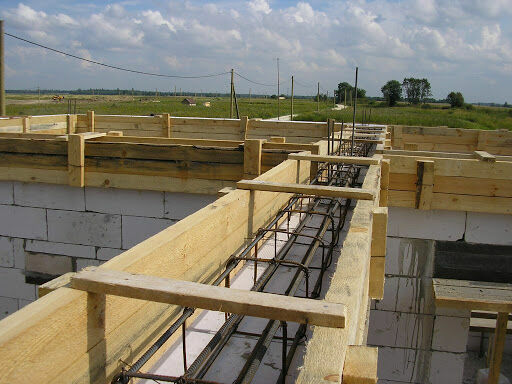
The technology of erecting a shed roof allows the absence of an armored belt. Experts recommend not to neglect this step, as it significantly increases the reliability of the structure.
It is recommended to create a Mauerlat from a bar, the width of which is equal to the thickness of the wall. Its height can vary between 5-20 cm. It is important to securely fix it on the walls.
A common mounting option for the Mauerlat:
- Install formwork from boards 10-15 cm wide along the perimeter of the walls.
- Fill it with concrete, installing a reinforcing frame.
- Threaded studs are installed in the concrete mortar, poured in sections of the front and rear walls. They are attached to the reinforcing structure by welding or wire. The preferred step for installing studs is 1 m.
- After the concrete mortar has completely dried, a Mauerlat beam is mounted on the studs. It is fixed with nuts and wide washers.
You can do without a concrete-reinforcing belt. In this case, at the stage of laying blocks or bricks, it is necessary to lay fired wire twisted in several layers. Its diameter should be 4-6 mm.
For a block structure, the wire is laid 2-3 rows lower, for a brick one - 5-6. The length of the wire must be sufficient for the subsequent winding and twisting of the Mauerlat with it. The recommended pitch for twists is 1 m with obligatory laying of wire in the corners of the building.
Step # 2 - Assembly of the truss system
Fastening the rafters is not difficult. Step-by-step assembly instructions will help speed up the process of building a roof.
At the first stage, cuts in the shape of a triangle are made at the bottom and at the top of one rafter. According to this model, similar actions are performed for each rafter. After that, rafters are installed at an equal distance from each other. Recommended installation step: for plank rafters - 60-70 cm, for timber - 1.5-2 m.
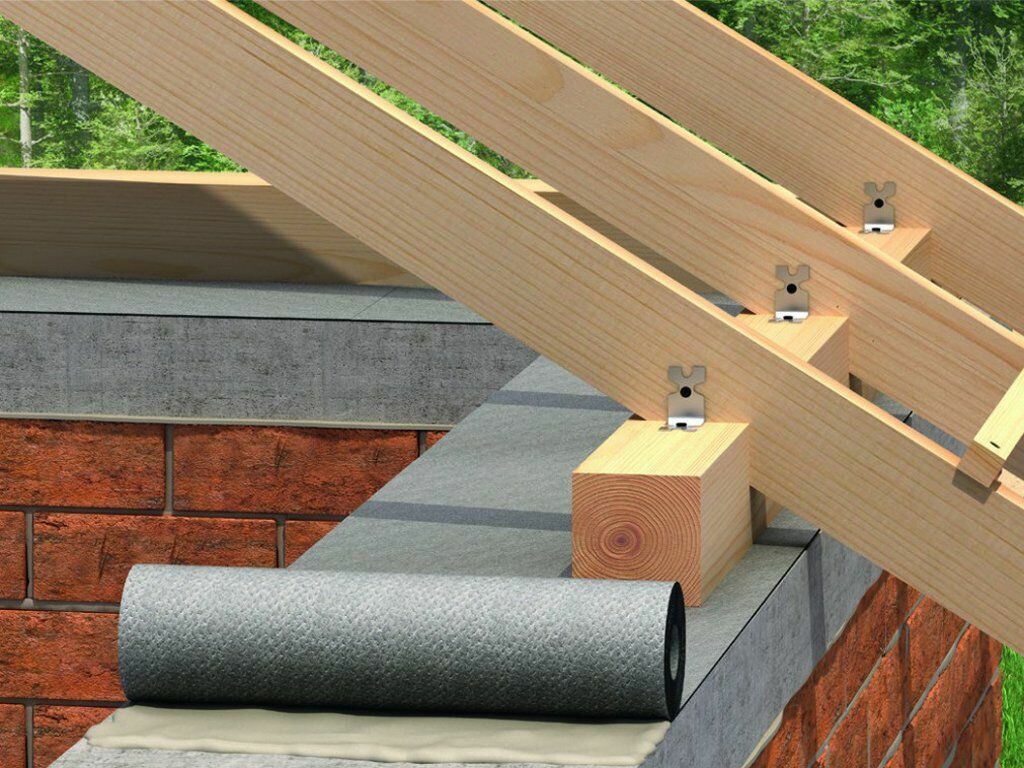
The notched mounting system provides a stronger and more secure mounting with a mauerlat. This design is safe and can withstand significant loads without moving or deforming.
You can perform an alternative mounting option. Two extreme rafter legs are installed along the gable of the roof. They are not attached to the Mauerlat. Threads are pulled between the ends of the legs and tied to screwed screws. Threads should be fixed in tightness.
Alternately lifting the rafter legs, wooden inserts are inserted under them, the edges are set using the building level (first of all along the facade, then along the back wall).
After that, with the help of perforated corners and self-tapping screws, the rafters are attached to the Mauerlat. By pulling a few more threads, a roof plane is created. The remaining elements of the truss system are mounted on pre-tensioned threads. At the end, fastening with a Mauerlat is carried out.
Each element must be carefully treated first with an antiseptic, then with a fire retardant. This minimizes the risk of fire and helps protect the roof from biological damage.
Rafter system with the same wall height
In such a house project, the slope of the slope will be provided by creating a truss from racks, floor beams and rafter legs. This design has a triangular shape.
Farm assembly must be carried out on the ground. The finished system is lifted onto the building by means of a crane. If a large opening has been created between the base and the top point, the truss must be equipped with reinforcing elements.
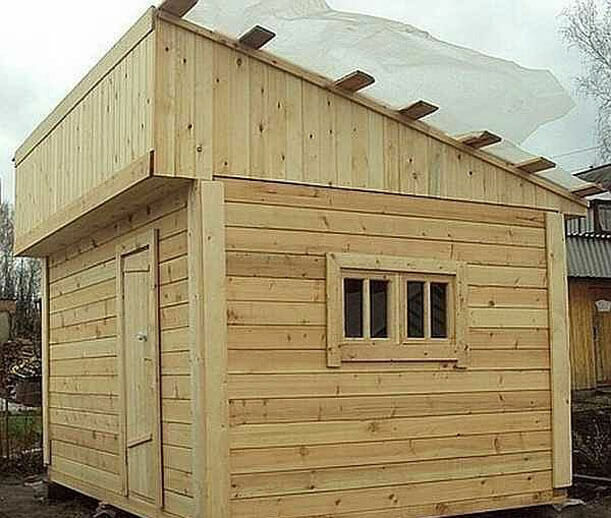
The advantage of the triangular truss system is that it does not require wall extensions. Its disadvantage is the additional cost of wood
For buildings with a small area, the use of short racks is allowed. The step of their installation must match the calculated gap between the rafters. Fastenings are carried out using corners.
The longer the rack, the higher the roof structure will be raised. Accordingly, there will be a sharper slope. This method can replace the creation of a farm. This method is used in the formation of the roof for utility and technical buildings.
Step # 3 - installation of roofing thermal insulation
Utility rooms can be left without insulation. For residential buildings - this element is required. Process roof thermal insulation may vary depending on the degree of inclination. This is due to the fact that a higher clearance ensures the convenience of work carried out inside. It is recommended to insulate the roof before installing the crate.
The process of working for a roof with a large gap:
- The waterproofing membrane is laid along the rafter legs inside the attic. You need to start from the bottom, putting each next part on 10-15 cm of the previous one. You can fasten the material with a stapler and steel staples.
- Using self-adhesive tape, the resulting joints overlap.
- From the inside, slats or boards are attached to the rafters. The step should be 1 m. This method of fastening will protect against possible damage to the waterproofing.
- Thermal insulation material is laid between the legs on top of the truss system. The width of the slabs should exceed the gaps between the legs of the rafters. The thickness of the waterproofing layer should be equal to the width of the rafters.
- The vapor barrier is laid on top of the insulation layer.
- After that, you can start assembling the crate.
Insulation of a flat roof differs significantly due to the inability to perform work inside the attic. The process must begin with fixing the tile bars along the bottom along the ends of the rafter legs. It is recommended to take a section of 3 cm. Then pieces of boards are attached over the bars and across the truss system. Their thickness should be 2.5 cm. For these purposes, plywood or chipboard, fiberboard, etc. can be used.
From above, the roof will look like niches, which are formed from rafter legs and tiled beams. Next, a layer of waterproofing is mounted on this structure. In this case, the film should repeat the shape of the formed niches. Insulation is laid in them and the resulting structure is covered with a layer of vapor barrier.
For a warming cake, polystyrene, mineral wool or cellulose is used. If the roof has a strong slope, it is recommended to purchase soft insulation. They are not inferior in functionality, but greatly simplify installation.
For a warming cake, polystyrene, mineral wool or cellulose is used. If the roof has a strong slope, it is recommended to purchase soft insulation. They are not inferior in functionality, but greatly simplify installation.
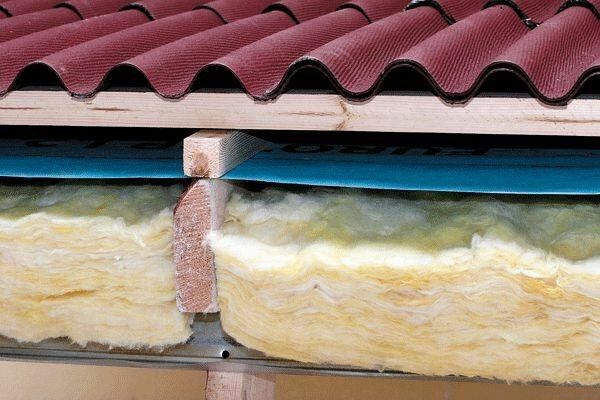
The minimum thickness of the thermal insulation layer is 10 cm. For buildings in cold regions, this figure is recommended to be increased several times.
Flat roofs are insulated with sawdust or expanded clay. This budget method has good waterproofing performance.
Step #4 - Creating the Roof Sheathing
The type of lathing is selected based on the intended material for the roof. Installation is carried out after the installation of the truss system is completed. Often a counter-lattice is installed between the crate and insulation.
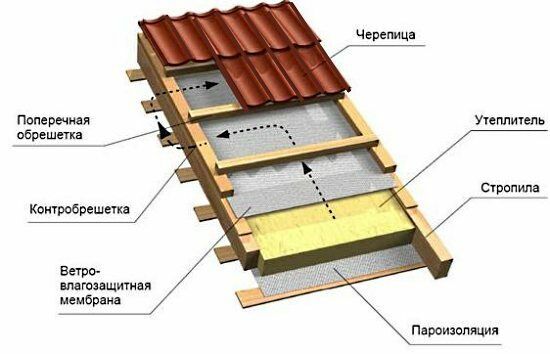
The counter-lattice is assembled from slats with a thickness identical to the width of the rafters. The gap obtained during installation performs the function of additional ventilation
A solid crate is installed under bituminous roll materials, flexible tiles, rebate. Such a crate is made of moisture-resistant plywood, boards 2.5 cm thick, moisture-resistant OSB-3 boards.
It is recommended to leave a gap of 1-1.5 cm between the elements of the crate. This will prevent them from deforming in the event of expansion due to weather conditions. The selected material is attached only to the rafter legs.
A sparse crate is installed under other types of roofing materials. Such a system involves the use of boards with a thickness of 2-2.5 cm, or slats with a cross section of 5 cm.

The diagram shows the types of crates. Depending on the chosen material for the roof, the gaps between the battens of the batten are calculated
Under each unit of ondulin and slate there should be at least three parts of the crate: along the edges and in the center. This will ensure reliable fixation and integrity of each element of the roof.
Such a crate is attached to the rafters with self-tapping screws. Their length should be two thicknesses of the crate fragment.
The choice of material for the roof
The main factor influencing the choice of material is the angle of inclination of the pitched roof. Below are recommendations for choosing a roof based on common slope angles:
- the rebate can be used even for flat roofs with a slope of 5 degrees;
- if the sheet of corrugated board completely covers the length of the slope, the minimum angle is 5 degrees. If the assembly of elements with transverse joints is used - from 20 degrees;
- the minimum angle for shingles is 11 degrees;
- install metal tile possible on roofs with an angle of 10-15 degrees;
- for slate and ondulin, the indicator must be at least 20;
- roofing made of soft material can even be laid on a sloping or flat roof.
Under a roof made of corrugated board or metal tiles, it is imperative to install a counter-lattice. It will not only provide a gap for ventilation, but also significantly increase the strength of the structure.
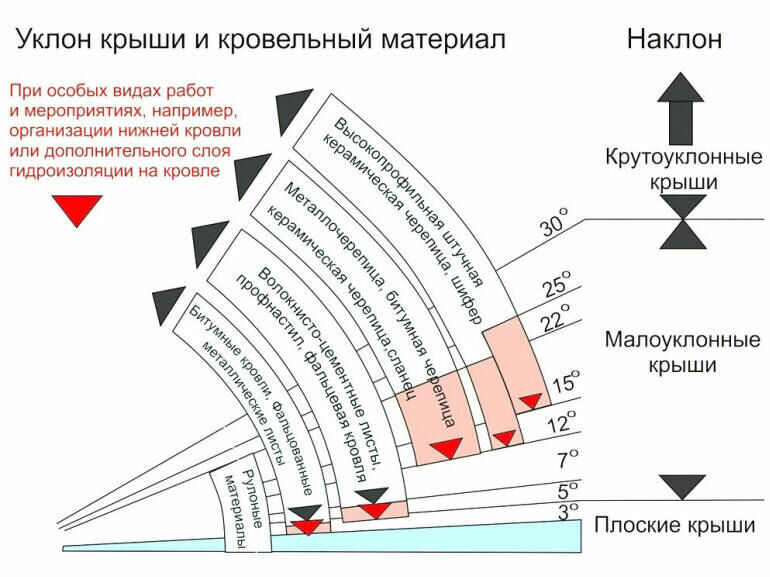
When choosing a roofing material, one should be guided not only by GOST, but also by the manufacturer's recommendations. Deviations from the specified operating instructions will lead to deformation and violation of the integrity of the roof
One of the advantages of a shed roof is the ability to use any roofing materials. The choice depends on the design of the building and its intended purpose.
For residential buildings, it is better to choose durable and visually attractive options. Roofing for utility rooms can be more budgetary.
Conclusions and useful video on the topic
Installing the roof rafters:
Step-by-step process of building a shed roof:
The process of building a pitched roof requires strict compliance with the requirements and standards. By following the manufacturer's recommendations for material processing and following the sequence of steps, you will get a reliable and safe design. A properly designed and assembled roof will be resistant to loads, which will be the key to a long service life.
If you have any questions on the topic of the article or you can supplement the material with valuable information regarding pitched roof arrangement, please leave your comments, share your experience - the communication block is located under the article.


